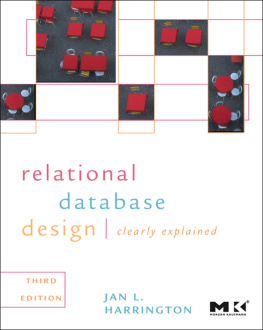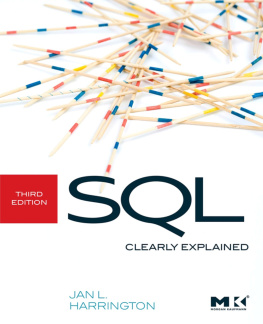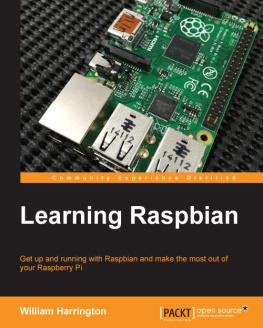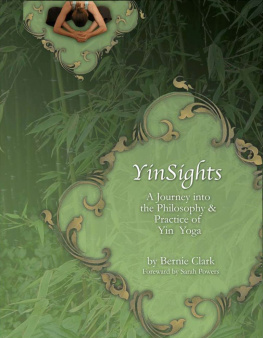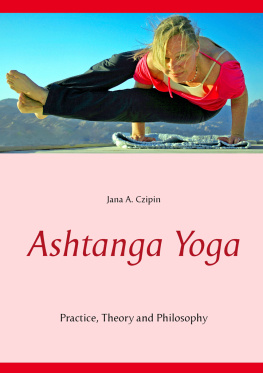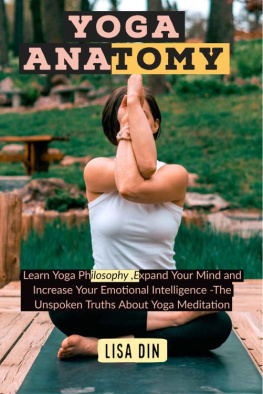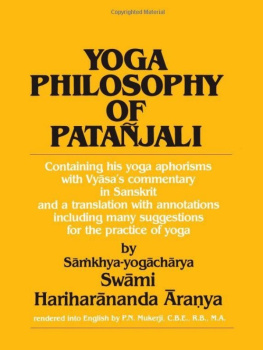Thinking Upside Down
Yoga Philosophy for Your Studio Practice
Michael Harrington
Queen Square
Copyright 2021 Michael Harrington
All rights reserved.
No part of this book may be reproduced, or stored in a retrieval system, or transmitted in any form or by any means, electronic, mechanical, photocopying, recording, or otherwise, without express written permission of the publisher.
Edited by Joseph JP Johnson
Printed in the United States of America
ISBN: 978-1736560006
Contents
Introduction
T he way we think about yoga shapes our experience of it. We do not enter a yoga studio without an expectation of what will happen there. We may think of yoga as a form of physical exercise, like a workout at the gym, or as something more spiritual, like a church service. Whatever our expectations are, they shape what we notice and what we ignore.
You may have never fully thought through what yoga is, but your mind already holds concepts that define it for you. What do you think a workout is, and does it affect only the body? What exactly is a body, and how is it related to the mind? Can you shape your mind by moving your body? You already have answers to these questions, even if you may not be able to state them clearly. Leaving your old answers behind and finding others can change your practice as much as your current efforts. Learning a new pose can be challenging, and practicing regularly is essential. But your experience of yoga will only deepen significantly when you change how you understand itwhen you change your concepts.
This book offers concepts that can reshape your experience of yoga. Many of them originated in India over two thousand years ago and rode the waves of Buddhist teaching that washed over China in texts and practices brought by scholars, monks, and invading armies. Chinese translators took Indian texts and, simply by translating them, connected them to concepts already within Chinese philosophical texts and meditative practices. These concepts began to circulate in China in the form of Yogcra Buddhism, which eventually developed into what we now call Zen.
No one in ancient India or China practiced anything like what we do in a modern yoga studio. They did not control the temperature of their practice room. And they did not move rapidly from pose to pose or use the wide variety of poses we are now familiar with. Their yoga practice was entirely a form of seated meditation, and they guided that practice with the concepts found in this book.
Being old does not make a concept good. Time may test ideas to make sure they are true, but time can also reinforce mistakes. The radicals of early twentieth-century China tended to solve this problem by rejecting traditional ways of thinking entirely. But some Chinese philosophers tried a different approach, refining traditional yoga concepts with the insights of newly developed sciences, such as psychology, and embroidering them with passages drawn from classical Chinese texts. Although this modern renovation made the traditional concepts clearer and more persuasive, the philosophers who performed it had one major weakness. They did not practice yoga! They ignored the meditative yoga that was well known in India and China, and they had no ability to practice modern postural yoga, which was only then coming into existence in India. They could not draw on their own experience, and they did not develop a practice for other people.
In this book, I have taken the missing stepconnecting the concepts of Buddhist and Chinese thinkers to a modern postural yoga practice, something that neither their ancient developers nor their modern interpreters imagined. Although I refer to Chinese concepts such as yin and yang , this is not a book about Yin Yoga (a form of yoga, in fact, developed and practiced primarily in the United States). Nor is it about Chinese analogs to modern postural yoga, such as Tai Chi. Yes, the concepts I explain can benefit people practicing Yin Yoga or Tai Chi. But I apply these concepts to the popular poses of modern yoga used in studios all over the world. This book, in other words, is about using traditional Chinese concepts to shape our experience of modern postural yoga.
Although the book is divided into sections organized by topic, the chapters stand alone and do not need to be read in order. For example, if you are interested in desire and how it relates to a yoga practice, you may skip to the chapter on desire. Or, if you are interested in how desire contributes to a decision-making process that involves other activities of the mind, you can read everything around the chapter on desire for context. The illustrations of poses in each chapter, as well as their descriptions, are intended to help you recognize the pose being discussed. They are not a practical guide to taking the pose. The practice of yoga should be undertaken only with the guidance of a qualified instructor.
Where Change Happens
When modern yoga instructors describe how our minds work, they tend to focus on the five mental activities listed at the beginning of the Yoga Stra and commonly referred to as the citta vritti the turnings of the mind. But the Yoga Stras activities come and go like cat naps. They pop up temporarily to correct the course of the lives we are already living, and we need them more or less often depending on who we are and what we are doing. In the pages that follow, you will discover the more basic mental activities that stay with us as long as we live, though a practice such as yoga can change how they work. Five of these activities were listed in the Thirty Verses, a poem composed by the Yogcra sage Vasubandhu. But here they are souped up with the addition of desire, an equally continuous sixth activity of the mind.
1. Continuous Activities
A n old Zen story tells of a rower in a dragon boat race. Before the race, he finds a quiet place by the river to sit and wait until he is needed. After the race, he returns to the place and sits down again, just as before. Everything appears the same. If you were shown a picture of the rower taken before the race and another taken afterward, you would not be able to tell the difference. But, between the two periods of sitting and waiting, his boat won the race.
The story ends with the observation that although the rower is in the same physical position before and after the race, it is only after the race that he can rest.
This story is not teaching us anything about dragon boat racing. The race is a metaphor for practice. The point is that although practice is important, we cannot easily explain what it does for us. Practice does not turn us into new people or give us special powers we did not already possess. After we practice, we do pretty much the same things we did before. We may not even see that we have undergone a change, especially since changing what we do is easier to notice than changing how we do it. The dragon boat racer is doing the same thing before and after the race. But after the race he experiences what he is doingsitting on the riverbankas rest.
Yoga is no more likely than any other practice to give us extraordinary powers or turn us into different people. It does its work within the activities that form our lives, whether we are practicing in a studio or shopping for groceries. So to understand what is happening in yoga, we first have to understand these ordinary activities of life, whether you call them turnings of the mind, as the Yoga Stra does, or activities of the mind with the Yogcra tradition. The most basic of them endure as long as life does, and so we call them continuous activitiesthey never go away.


